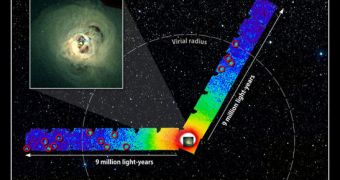Astronomers recently managed to snap a new view of the Perseus Galaxy, one of the most beautiful in the known Universe. The crystal-clear image was snapped using the Suzaku space telescope, which conducts survey in X-ray wavelengths.
The observatory is operated by the Japan Aerospace Exploration Agency (JAXA). It was recently pointed towards Perseus, which lies some 250 million light-years away from Earth. This is relatively close in astronomical terms.
According to experts who looked over the new photo, the telescope was able to picture the size, mass and chemical composition of the massive cosmic structure in unprecedented detail. Suzaku proved its worth on many occasions, but it really exceeded its own performances this time.
The new data revealed that Perseus is some 11.6 million light-years across, which is huge compared to the Milky Way. Our galaxy has a diameter of “only” 100,000 light-years, Space reports.
The telescope also revealed that the total mass of the galaxy is equivalent to about 660 trillion solar masses, as opposed to our galaxy's 100 billion solar masses. Such data are important because they help experts calculate how galaxies evolved as the Universe expanded.
“Understanding the content of normal matter in galaxy clusters is a key element for using these objects to study the evolution of the universe,” explains NASA Goddard Spaec Flight Center (GSFC) expert Adam Mantz, the coauthor of the new investigation.
Additionally, the Suzaku datasets can be used to assess how normal matter is distributed throughout the Universe in relation to dark matter. The latter is not visible directly, and its existence is inferred from the interactions it has with normal matter via gravity.
In the past, experts believed that normal matter was present in clusters in small amounts, with the bulk of galactic masses being made up of dark matter. Statistics show that only 4.6 percent of the Universe's mass is made up of normal matter.
But the new data indicates that astronomers filed to account got the way hot gases create clusters inside large galaxies, when crunching up those numbers. Details of the new study appear in the March 25 issue of the top journal Science.
“The distribution of these clumps and the fact that they are not immediately destroyed as they enter the cluster are important clues in understanding the physical processes that take place in these previously unexplored regions,” explains scientist Steve Allen.
He is the principal investigator on the datasets Suzaku sends back. The expert holds an appointment at the Stanford University Kavli Institute for Particle Astrophysics and Cosmology.

 14 DAY TRIAL //
14 DAY TRIAL //